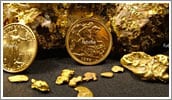Gold is nearing the end of a decade-long run that has lifted prices by more than 600 percent, some market observers believe.
 The yellow metal has been a top-performing asset since 2001, as portfolio diversification, concerns over sovereign risk and rock-bottom interest rates aided to push prices from a low around $250 an ounce in 2001 to a height above $1,920 in September 2011.
The yellow metal has been a top-performing asset since 2001, as portfolio diversification, concerns over sovereign risk and rock-bottom interest rates aided to push prices from a low around $250 an ounce in 2001 to a height above $1,920 in September 2011.
In 2012 or during the first quarter of the next year, it is likely gold to surpass that level, potentially breaking through the $2,000 an ounce level.
However, a gradual normalisation of the broader financial landscape worldwide in coming years will likely divert market players appetite to other profitable assets.
If the the gold market is nearing the closing phases of its decade-long bull run, a secular retreat in the price will naturally unroll.
Once the macroeconomic backdrop reverts, naturally interest in investment in gold will decline, but this is not expected to happen before the second half of 2012. During the first half, a rising dollar and increased risk aversion, will still maintain the yellow metal’s price at relatively steady levels, despite curbing gains.
In 2011, central banks increased their gold lending to commercial banks, which used the metal to raise U.S. dollars. This year, physical bar sales are also expected to rise above one percent in the first half of the year, after surging by more than a third last year. Demand for gold bars was particularly strong in German-speaking Europe last year, as the euro debt crisis unfolded.
World investment is expected to decline by some 250 tonnes in the first half of 2012 from the final six months of last year.
Gold’s largest handicap in coming years is likely to be the strengthening dollar.
On the supply side of the market, mine output is expected to rise nearly 3 percent in the first half of the year, although most new supply is projected to come from existing, rather than new, projects.
Gold scrap supply is seen dipping around 3 percent, however, as most available material will already have hit the market after a prolonged period of gold price strength. New sellers may also be discouraged by expectations of higher prices.
Economic fundamentals call for far lower gold prices in the long term in order to achieve balance.
However, the market’s shorter term foundations are not as shaky as the long term.



































